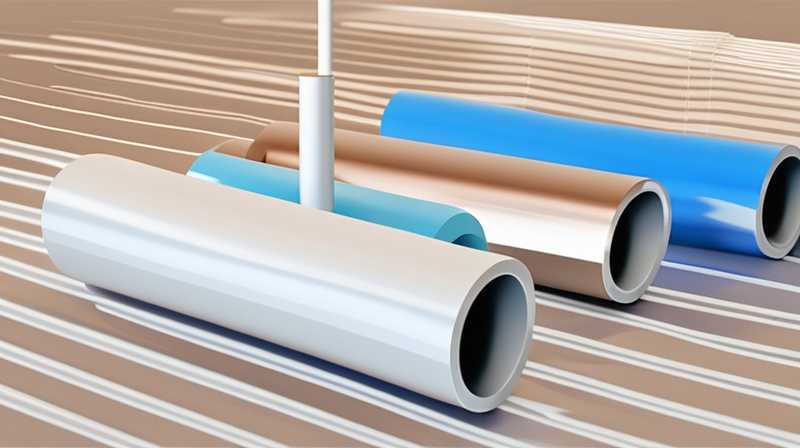
Connecting solar PVC pipe to a self-priming pump involves a few essential steps to ensure efficiency and functionality. 1. Gather necessary materials, 2. Prepare the connections, 3. Install the pump, 4. Test the system for leaks. When preparing the connections, it is crucial to ensure that the fittings are compatible with both the PVC piping and the pump’s inlet and outlet ports. Proper alignment and secure bonding will promote optimal performance and prevent any water leakage.
1. NECESSARY MATERIALS
Before embarking on the task of connecting a solar PVC pipe to a self-priming pump, acquiring the right tools and materials is pivotal. The essential items include solar PVC pipes, which are specifically designed to endure outdoor conditions, preventing degradation under UV exposure, and self-priming pumps, which facilitate the automatic removal of air to maintain water flow. Additional materials may consist of PVC fittings, Teflon tape, and solvent cement.
Utilizing an appropriate size of solar PVC pipe that matches the specifications of the pump ensures seamless connectivity and prevents inefficiencies associated with mismatched diameters. The self-priming pump must be selected based on the required flow rate and pressure for the specific application, as this can significantly impact the overall performance of the system.
2. PREPARING THE CONNECTIONS
Once the materials are gathered, the next critical step involves preparing the connections. This entails cutting the solar PVC pipe to the necessary lengths and applying the correct fittings. For effective preparation, it is important to utilize a pipe cutter for a clean cut, which minimizes any irregularities that could hinder the seal between the pipe and pump fittings.
In addition to cutting, deburring the cut edges is essential. This is done by removing any rough edges that might cause leaks or impede water flow. After ensuring that the cuts are smooth, each piece of pipe must be thoroughly cleaned, particularly at the joints where they will connect to the fittings or the self-priming pump. Using PVC cleaner ensures the removal of any contaminants, which is vital for achieving a strong adhesive bond.
3. INSTALLING THE PUMP
The subsequent stage is the installation of the self-priming pump. The positioning of the pump should be deliberate, ideally at a lower elevation than the water source to promote efficient priming. Before placing the pump, ensure that the base is solid and stable to avoid vibration and potential disconnection during operation.
When connecting the solar PVC pipe to the pump, use the appropriate fittings to secure both the inlet and outlet sides. Ensure that the fittings are tightly fastened but also avoid over-tightening as this can damage the threads. After the connections are securely made, it is prudent to apply Teflon tape to the threaded areas to enhance the seal against leaks.
4. TESTING FOR LEAKS
The final step in the process involves thorough testing for any leaks. To begin testing, fill the system with water and check each connection point carefully. Observing for leaks during this initial fill is crucial; if any leak is detected, it should be promptly addressed, either by tightening the connection or applying additional adhesive or sealant.
Moreover, once the system is filled and has been tested for stability, the self-priming pump can be activated. Monitoring its performance during start-up and initial operation is essential. Listen for any unusual noises or vibrations that may indicate improper installation or connection issues. Properly functioning pumps will exhibit a steady flow without significant interruptions or air pockets.
FREQUENTLY ASKED QUESTIONS
WHAT SIZE PVC PIPE SHOULD I USE FOR MY SELF-PRIMING PUMP?
The size of the PVC pipe that should be used in conjunction with a self-priming pump largely depends on the pump’s specifications and the desired flow rate. Typically, if the pump’s inlet and outlet ports are 1 inch, using 1-inch PVC pipes would be optimal for maintaining flow efficiency. However, if the pump is designed for larger volumes, 1.5-inch or 2-inch pipes may be more suitable. Additionally, using pipe sizes that are too small can lead to excessive friction loss, adversely affecting the pump’s performance. Therefore, always refer to the pump’s specifications and guidelines to ensure compatibility and effectiveness.
HOW DO I ENSURE MY CONNECTIONS ARE WATER TIGHT?
Ensuring water-tight connections requires careful preparation, the right materials, and proper technique. Start with clean, smooth cuts on your PVC pipes and ensure they are dry before applying any adhesive. Using high-quality PVC cement according to the manufacturer’s instructions is crucial for achieving a robust bond. Applying Teflon tape to threaded connections also helps in preventing leaks. After assembly, testing your connections under pressure, and watching for leaks can further guarantee that the system operates efficiently without any water loss.
CAN A SELF-PRIMING PUMP BE USED FOR SOLAR WATER HEATING SYSTEMS?
Yes, self-priming pumps can be effectively utilized in solar water heating systems. These pumps are designed to lift water from a source, often found at lower elevations, to the storage tank or distribution area. When properly connected to a solar PVC piping system, self-priming pumps efficiently circulate water, enabling effective heat transfer. It’s essential, however, to consider the pump’s specifications, including flow rate and pressure capabilities, to ensure compatibility with the solar heating setup for optimal performance.
SIGNIFICANT TAKEAWAYS
Connecting a solar PVC pipe to a self-priming pump enhances water management efficiency, extends the life of the equipment, and maximizes performance. Careful selection of materials, adherence to proper connection techniques, and comprehensive testing are paramount for ensuring a reliable system. Taking time in the preparation and installation phases will mitigate future issues and promote long-term satisfaction with the water management system. By ensuring all fittings are compatible, stabilizing the pump during installation, and conducting thorough testing, users can enjoy an effective and efficient water delivery system for various applications. Through attention to detail, users can achieve a seamless integration of solar PVC piping with self-priming technologies, leading to sustainable and dependable water solutions.
Original article by NenPower, If reposted, please credit the source: https://nenpower.com/blog/how-to-connect-solar-pvc-pipe-to-self-priming-pump/


